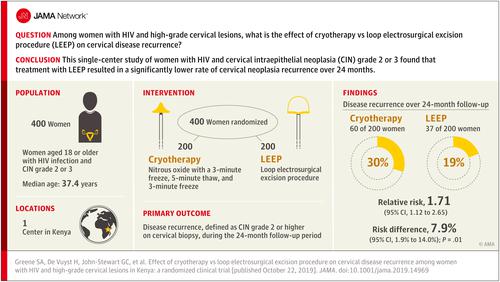Our official English website, www.x-mol.net, welcomes your
feedback! (Note: you will need to create a separate account there.)
Effect of Cryotherapy vs Loop Electrosurgical Excision Procedure on Cervical Disease Recurrence Among Women With HIV and High-Grade Cervical Lesions in Kenya
JAMA ( IF 63.1 ) Pub Date : 2019-10-22 , DOI: 10.1001/jama.2019.14969 Sharon A Greene 1, 2 , Hugo De Vuyst 3 , Grace C John-Stewart 1, 2, 4, 5 , Barbra A Richardson 1, 6, 7 , Christine J McGrath 1 , Kara G Marson 1 , T Tony Trinh 1 , Nelly Yatich 1 , Catherine Kiptinness 1 , Anthony Cagle 1 , Evans Nyongesa-Malava 1 , Samah R Sakr 8 , Nelly R Mugo 1, 9 , Michael H Chung 1, 2, 4
JAMA ( IF 63.1 ) Pub Date : 2019-10-22 , DOI: 10.1001/jama.2019.14969 Sharon A Greene 1, 2 , Hugo De Vuyst 3 , Grace C John-Stewart 1, 2, 4, 5 , Barbra A Richardson 1, 6, 7 , Christine J McGrath 1 , Kara G Marson 1 , T Tony Trinh 1 , Nelly Yatich 1 , Catherine Kiptinness 1 , Anthony Cagle 1 , Evans Nyongesa-Malava 1 , Samah R Sakr 8 , Nelly R Mugo 1, 9 , Michael H Chung 1, 2, 4
Affiliation

|
Importance
The World Health Organization recommends cryotherapy or loop electrosurgical excision procedure (LEEP) for histologically confirmed cervical intraepithelial neoplasia (CIN) grade 2 or higher regardless of HIV status. Cryotherapy is more feasible in resource-limited settings but may be less effective for women living with HIV. Objective
To evaluate whether cryotherapy or LEEP is a more effective treatment for high-grade cervical lesions among women with HIV. Design, Setting, and Participants
Single-center randomized trial conducted among women with HIV and CIN grade 2 or 3. From June 2011 to September 2016, women with HIV in Kenya underwent cervical screening with Papanicolaou testing and confirmatory biopsy. The final date on which a study procedure was administered was September 7, 2016. Interventions
Women with HIV infection and CIN grade 2 or 3 were randomized 1:1 to receive cryotherapy (n = 200) or LEEP (n = 200) and were followed up every 6 months for 24 months with a Papanicolaou test and confirmatory biopsy. Main Outcome and Measures
The primary outcome was disease recurrence, defined as CIN grade 2 or higher on cervical biopsy, during the 24-month follow-up period. Results
Among 400 women who were randomized (median age, 37.4 [interquartile range, 31.9-43.8] years), 339 (85%) completed the trial. Over 2 years, 60 women (30%) randomized to cryotherapy had recurrent CIN grade 2 or higher vs 37 (19%) in the LEEP group (relative risk, 1.71 [95% CI, 1.12-2.65]; risk difference, 7.9% [95% CI, 1.9%-14.0%]; P = .01). Adverse events occurred in 40 women (45 events, including change in pathology and death due to other causes) in the cryotherapy group and in 30 women (38 events, including change in pathology and unrelated gynecological complications) in the LEEP group. Conclusions and Relevance
In this single-center study of women with HIV infection and CIN grade 2 or 3, treatment with LEEP compared with cryotherapy resulted in a significantly lower rate of cervical neoplasia recurrence over 24 months. Cost-effectiveness analysis is necessary to determine whether the additional benefit of LEEP represents an efficient use of the additional resources that would be required. Trial Registration
ClinicalTrials.gov Identifier: NCT01298596.
中文翻译:

冷冻疗法与环形电外科切除术对肯尼亚艾滋病毒携带者和高级别宫颈病变女性宫颈疾病复发的影响
重要性 世界卫生组织建议对组织学证实的 2 级或更高级别的宫颈上皮内瘤变 (CIN) 进行冷冻疗法或环形电外科切除术 (LEEP),无论 HIV 状态如何。冷冻疗法在资源有限的环境中更为可行,但对于感染艾滋病毒的女性来说可能效果较差。目的 评估冷冻疗法或 LEEP 是否是治疗 HIV 女性重度宫颈病变更有效的方法。设计、背景和参与者 在患有 HIV 和 2 级或 3 级 CIN 的女性中进行单中心随机试验。从 2011 年 6 月到 2016 年 9 月,肯尼亚的 HIV 女性接受了宫颈筛查,包括巴氏检测和确认性活检。实施研究程序的最后日期是 2016 年 9 月 7 日。 干预措施 将 HIV 感染且 CIN 2 级或 3 级的女性按照 1:1 的比例随机分配接受冷冻疗法 (n = 200) 或 LEEP (n = 200),并进行随访通过巴氏试验和确认性活检,每 6 个月增加一次,持续 24 个月。主要结果和措施 主要结果是在 24 个月的随访期内疾病复发,定义为宫颈活检中 CIN 2 级或以上。结果 在 400 名随机分配的女性(中位年龄 37.4 [四分位距,31.9-43.8] 岁)中,339 名 (85%) 完成了试验。 2 年多时间里,随机接受冷冻治疗的 60 名女性 (30%) 复发了 2 级或更高级别的 CIN,而 LEEP 组中有 37 名 (19%) 女性出现复发(相对风险,1.71 [95% CI,1.12-2.65];风险差异,7.9%) [95% CI,1.9%-14.0%];P = .01)。 冷冻治疗组有 40 名女性(45 名事件,包括病理变化和其他原因导致的死亡)发生不良事件,LEEP 组有 30 名女性(38 名事件,包括病理变化和无关的妇科并发症)。结论和相关性 在这项针对 HIV 感染且 CIN 2 级或 3 级女性的单中心研究中,与冷冻疗法相比,LEEP 治疗可显着降低 24 个月内宫颈肿瘤复发率。必须进行成本效益分析,以确定 LEEP 的额外好处是否代表了所需额外资源的有效利用。试验注册 ClinicalTrials.gov 标识符:NCT01298596。
更新日期:2019-10-22
中文翻译:

冷冻疗法与环形电外科切除术对肯尼亚艾滋病毒携带者和高级别宫颈病变女性宫颈疾病复发的影响
重要性 世界卫生组织建议对组织学证实的 2 级或更高级别的宫颈上皮内瘤变 (CIN) 进行冷冻疗法或环形电外科切除术 (LEEP),无论 HIV 状态如何。冷冻疗法在资源有限的环境中更为可行,但对于感染艾滋病毒的女性来说可能效果较差。目的 评估冷冻疗法或 LEEP 是否是治疗 HIV 女性重度宫颈病变更有效的方法。设计、背景和参与者 在患有 HIV 和 2 级或 3 级 CIN 的女性中进行单中心随机试验。从 2011 年 6 月到 2016 年 9 月,肯尼亚的 HIV 女性接受了宫颈筛查,包括巴氏检测和确认性活检。实施研究程序的最后日期是 2016 年 9 月 7 日。 干预措施 将 HIV 感染且 CIN 2 级或 3 级的女性按照 1:1 的比例随机分配接受冷冻疗法 (n = 200) 或 LEEP (n = 200),并进行随访通过巴氏试验和确认性活检,每 6 个月增加一次,持续 24 个月。主要结果和措施 主要结果是在 24 个月的随访期内疾病复发,定义为宫颈活检中 CIN 2 级或以上。结果 在 400 名随机分配的女性(中位年龄 37.4 [四分位距,31.9-43.8] 岁)中,339 名 (85%) 完成了试验。 2 年多时间里,随机接受冷冻治疗的 60 名女性 (30%) 复发了 2 级或更高级别的 CIN,而 LEEP 组中有 37 名 (19%) 女性出现复发(相对风险,1.71 [95% CI,1.12-2.65];风险差异,7.9%) [95% CI,1.9%-14.0%];P = .01)。 冷冻治疗组有 40 名女性(45 名事件,包括病理变化和其他原因导致的死亡)发生不良事件,LEEP 组有 30 名女性(38 名事件,包括病理变化和无关的妇科并发症)。结论和相关性 在这项针对 HIV 感染且 CIN 2 级或 3 级女性的单中心研究中,与冷冻疗法相比,LEEP 治疗可显着降低 24 个月内宫颈肿瘤复发率。必须进行成本效益分析,以确定 LEEP 的额外好处是否代表了所需额外资源的有效利用。试验注册 ClinicalTrials.gov 标识符:NCT01298596。











































 京公网安备 11010802027423号
京公网安备 11010802027423号